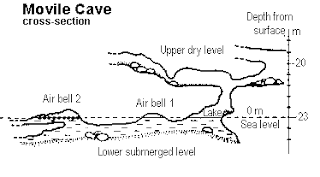
The reason for such a high interest from such a diverse audience are various and spectacular:
* it is a peculiar, practically unique environment, until now the only cave ecosystem completely driven by chemosynthesis (chemosynthesis = production of organic molecules using chemical energy rather than light);
* it is an extremely small and fragile environment which deserves our protection;
* it is one of the richest cave ecosystems regarding the number of species;
* more than 30 new species for science were described from this cave, and all are endemic (i.e, they live only in this ecosystem);
* it can serve as a valuable model for understanding how life can thrive even in the absence of light and under extreme conditions;
* the history of its discovery and research is one of committment and dedication.

While excavating for a major construction project in 1986, engineers happened to find a cave in which extraordinary conditions prevail. Named the Movile cave, it is the site of a hitherto unknown groundwater ecosystem that is rich in hydrogen sulfide (8-12 mg/l) and in contact with an atmosphere poor in oxygen (7-10%), rich in carbon dioxide (2-3.5%), and also containing significant amounts of methane (1-2%). Its exploration began in 1990. Until research teams began exploring Movile Cave, its 12000 square meters were entirely sealed off. The cave had no natural entrance and was discovered by accident during some geological research in the area.

The entrance is represented by a shaft with a depth of 18 meters. With a total length of about 300 meters it is a relatively small cave with narrow passages covered with clay. It is developed mainly horizontal with some pits which do not exceed 3 meters. In its lower part there is a small lake which connects the cave with the groundwater table. The passages continue underwater and are forming 3 air bells where the atmosphere is very rich in carbondioxide (up to ten times more than outside) and poor in oxygen (one third of the outside atmosphere).

When Earth's climate changed 5.5 million years ago, the area went from being tropical to temperate. The only animals that survived were those living in warm caves underground. Movile Cave, is one of Earth's most unusual ecosystems, populated with invertebrates that have adapted -- through a process called troglomorphy -- to their underground prison. They have done this by losing pigmentation, learning to navigate blind, and surviving on bacteria and fungi that derive energy from the sulfide hot springs beneath the cave. The predatory leeches, rare water scorpions, and other inhabitants of Movile Cave are similar to species found in deep sea vent communities. They depend on chemoautotrophic organisms (users of chemical energy) instead of the more usual photoautotrophic organisms (users of photosynthetic energy). Forty-six species of terrestrial and aquatic invertebrates have thus far been identified to inhabit this ecosystem, of which 31 are of a previously unknown kind. The vast majority are anthropods belonging to the classes of Arachnida, Crustacea, Myriapoda, and Insecta. Eighteen aquatic species in the cave belong to the flatworms, round worms, microscopic animals related to round worms, segmented worms, etc. A blind leech, a snail, and a blind water-scorpion have also been identified. The discoveries include grazers such as four species of isopods, or pillbugs, six springtails, a millipede, and a bristletail. Among the new species of carnivores are two pseudoscorpions, a 2-inch-long centipede, a worm-sucking leech, four spiders, and a water scorpion.


Access into the cave is permitted only for research purposes with the permission of the custodians, trips into the cave are limited at two hours, twice a month while no more than 3 people can enter at the same time, clean footwear and coveralls have to be worn to avoid contamination of the cave, two gates and an airtight lid are protecting the cave from unauthorized access and influences from the outside (gas exchange, temperature fluctuations and species immigration).

The cave is declared as a protected area, both by the city council of Mangalia and by the Romanian Academy of Sciences and falls under the regulations of the Environmental Protection Law of Romania. The custody of the cave belongs to a consortium made up by representatives of the Group for Underwater and Spelological Exploration and the Local Council of Mangalia.



0 comments:
Post a Comment